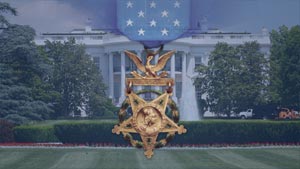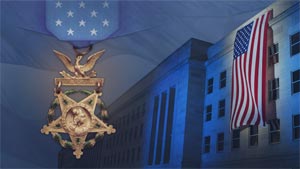MEDAL OF HONOR
Korean WarPrivate Bruno R. Orig

hometown
Honolulu, Hawaii
Enlistment date
August 1950
Military Occupation (MOS)
Infantryman (11B)
Unit
Company G, 2nd Battalion, 23rd Infantry Regiment, 2nd Infantry Division
Deployments
Korea, 1950
Bruno Orig was born in January 1930, in Honolulu, Hawaii. He was one of eight children raised in Honolulu by his mother Gregoria, father Hilario Orig (who died at age 41) and stepfather Leon Omboy. All three of his parents came to Hawaii from the Philippines.
Bruno’s father, stepfather, older brother and younger brother all served in the U.S. Army in WWI, WWII and Vietnam. He was 11 years old, living in Honolulu, when Pearl Harbor was attacked on Dec. 7, 1941, spurring the United States to enter WWII.
Soon after graduating from Farrington High School in 1949, Bruno enlisted in the U.S. Army and was trained as a light weapons infantryman. Pvt. Orig was assigned to Company G, 2nd Battalion, 23rd Infantry Regiment, 2nd Infantry Division, in South Korea. After only three months in country, Orig distinguished himself by extraordinary heroism in action against enemy forces in the vicinity of Chipyong-ni on Feb. 15, 1951.
During fierce fighting, the 20-year-old Orig removed his fellow wounded Soldiers to a place of safety and noticed that all except one man of a machine-gun crew had been wounded. Without hesitation, he volunteered to man the weapon. Remaining in this position, Orig placed such effective fire on the enemy that a withdrawing friendly platoon was able to move back without a single casualty. He continued to inflict heavy casualties on the enemy until the company positions were overrun. Later that day, when the lost ground was recaptured, Orig was found dead beside his weapon and the area in front of his gun was littered with enemy dead.
After Bruno died in combat, his younger brother Francis Omboy ended up serving in the Army and fought in Vietnam. Bruno belonged to a family that was rich in military service, family values, and selfless sacrifice. His sister Loretta, at 91 years old, is the only living member of the eight Orig/Omboy children, and their family military service has continued.
The Battle
Extraordinary heroism and selfless sacrifice
February 15, 1951 | Vicinity of Chipyong-ni, Korea

23rd Infantry Regiment, 2nd Infantry Division
Distinctive unit insignia of the 23rd Infantry Regiment, featuring elements paying homage to the regiment's history in the Civil War, Philippine service and World War I. Read Full Unit History
Pvt. Bruno R. Orig distinguished himself by acts of gallantry and intrepidity above and beyond the call of duty while serving with Company G, 2nd Battalion, 23rd Infantry Regiment, 2nd Infantry Division, in the vicinity of Chipyong-ni, Korea, on Feb. 15, 1951.
While returning from a wire-laying mission, Orig saw several of his comrades wounded during a fierce enemy attack. With complete disregard for his own safety, Orig went to them and remained in an exposed position to administer first aid. With the assistance of several comrades from the company command post, Orig began removing the wounded to a place of safety.
While returning from one of these trips, Orig noticed that all except one man of a machine-gun crew had been wounded. Without hesitation, he volunteered to man the weapon. Remaining in this position, Orig placed effective fire on the enemy, allowing a friendly platoon to withdraw without a single casualty. Orig continued to inflict heavy casualties on the enemy until the company positions were overrun.
Later that day, when the lost ground was recaptured, Orig was found dead beside his weapon, and the area in front of his gun was littered with several dead enemy soldiers.
RELATED STORIES FROM ARMY.MIL
23rd Infantry Regiment, 2nd Infantry Division

23rd Infantry Regiment, 2nd Infantry Division
Distinctive unit insignia of the 23rd Infantry Division. The shield colors of blue and white indicate the infantry. The Civil War service is indicated by the white cross of the 5th Corps and the early Philippine service by the sea lion taken from the seal of Manila. The Mont Blanc Campaign of October 1918 in World War I is commemorated by the outline of the lower half of the shield. The Regiment has the unique distinction of being the first American regiment to circumnavigate the globe and this is indicated in the base of the shield.
The 23rd Infantry Regiment was constituted in 1861 as a unit of the regular Army. It served in the Civil War, the Indian Wars, the Spanish-American War and the Philippine War before being assigned to the 2nd Infantry Division in 1917, with whom it served in World War I, World War II and the Korean War.
The 2nd Infantry Division was constituted in 1917 as a unit of the regular Army and organized in France from units assigned to the American Expeditionary Forces, including a U.S. Marine Corps brigade. The division fought in all the major battles of 1918, such as Belleau Wood, Soissons, St. Mihiel and the Meuse-Argonne.
After occupation duty in Germany, the 2nd Infantry Division moved to the United States in 1919, replacing the U.S. Marine Corps brigade with an Army brigade. Between the world wars, it tested the Triangular Infantry Division concept that the Army would use in World War II and the Korean War.
In 1943, the 2nd Infantry Division deployed to the United Kingdom, and then to France in June 1944, where they fought from Normandy to Germany, playing a vital role in the Battle of the Bulge in December 1944. Resuming the offensive, the division crossed the Rhine River in March 1945 and was in Czechoslovakia when Germany surrendered. The 2nd Infantry Division returned to the United States in July 1945 to prepare for the invasion of Japan, but the war ended before it could deploy. Instead, the division moved to Fort Lewis, Washington.
In July 1950, the 2nd Infantry Division became the first U.S. division to reinforce the Eighth Army in Korea. It helped hold the Pusan Perimeter and then advanced with United Nations forces into North Korea. In November, the Chinese launched a massive offensive that forced the Eighth Army to withdraw from North Korea. The 2nd Infantry Division covered the right flank and suffered severe casualties as it fought its way past enemy roadblocks in what became known as The Gauntlet. After reconstitution in South Korea, the division saw heavy combat in the drive north to the 38th Parallel from January to June 1951. During that period the division's 23rd Regimental Combat Team inflicted a major defeat on the Chinese at Chipyong-ni. In the war's final two years, the 2nd Infantry Division fought for ridges and outposts, including a series of battles at Bloody Ridge, Heartbreak Ridge and Old Baldy.
After the armistice, the division remained in Korea until 1954; then its colors were transferred to Fort Lewis and used to reflag the 44th Infantry Division as the 2nd Infantry Division. In 1956, the division moved to Alaska, as part of an Operation Gyroscope rotation, in which it switched places with the 71st Infantry Division. In June 1958, the division's colors were transferred to Fort Benning, Georgia, and used to reflag the 10th Infantry Division as the 2nd Infantry Division.
In July 1965, the 2nd Infantry Division and the 1st Cavalry Division in Korea exchanged their colors and unit designations as the Army created the 1st Cavalry Division (Airmobile) at Fort Benning using units from the 11th Air Assault Division and the 2nd Infantry Division.
Since 1965, the 2nd Infantry Division has remained on the peninsula defending South Korea, which included clashes with North Korean infiltrators in the 1960s. In 2004, one of its brigade combat teams deployed from Korea to Iraq.

